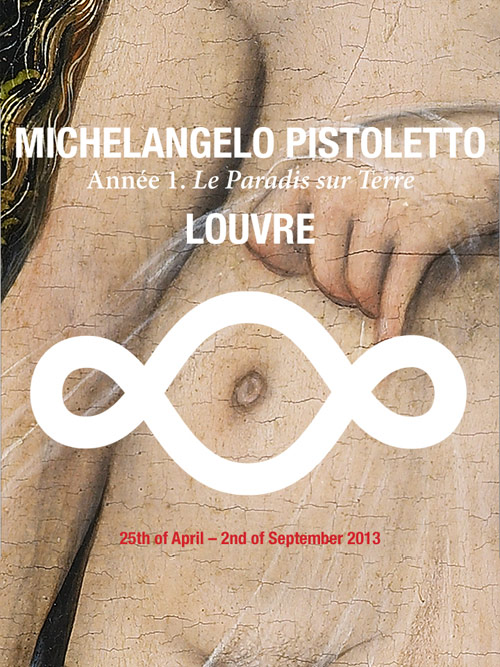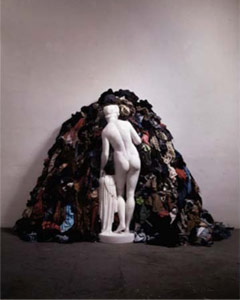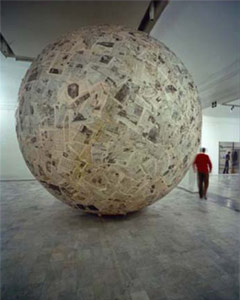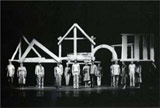“Année 1 – Le Paradis sur Terre”
April 25 – September 2 2013
opening April 24 2013
Musée du Louvre, Department of Paintings,
Department of Greek, Etruscan and Roman Antiquities, Medieval Louvre
Curators:
Marie-Laure Bernadac, Marcella Lista, assisted by Pauline Guélaud

The aim of this new series is not only to present works offering a fresh perspective on the museum’s permanent collections, which has been the founding principle of the “Counterpoint” exhibitions, but also to take advantage of the artist’s presence to organize a program of fruitful encounters in collaboration with the museum’s educational and cultural staff, as well as discussions and performances in the auditorium and in the Tuileries gardens.
Of all the contemporary artists selected so far to be given carte blanche during a residency at the Louvre, the choice of Pistoletto, one of the leading figures of the Italian Arte Povera movement, undoubtedly underscores the multidimensionality of space and time more than ever before: the past embodied by the museum’s own holdings, the present of visitors captured in its mirrors, and the future heralded by the Third Paradise symbol, displayed on the facade of the pyramid, a work created by the artist especially for this exhibition.
Taking as its title “Year One, Paradise on Earth,” the exhibition marks the transition to a new era, one of human, social, cultural and political transformation, celebrated around the world on December 21, 2012, the Rebirth-day, through various installations and performances at a number of high-profile venues, including the Louvre’s Cour Napoléon.
 Michelangelo Pistoletto, La Venere degli Stracci |
By intervening within several departments at the museum (Paintings, Sculptures, Medieval Louvre), through his works Pistoletto instills a dialogue with the history of art, from antiquity to present times, and embodies the meeting of disparate civilizations. This intervention thus echoes the essential elements of what constitutes a museum in the twenty-first century. From his first mirror paintings, which prompted a reconsideration of the purpose of art and challenged the very notion of perspective, to his most recent works, such as The Mirror of Judgment or Il Tempo del Giudizio, Pistoletto integrates the viewer into the composition, bringing us face to face with our own responsibility in the world’s evolution. The founding of Cittadellarte in the artist’s hometown of Biella (Italy) in 1996 stands as the most evident manifestation of his transition from individual creation, with his early investigations of self-portraiture, to collective and international creation, joining participants from several different disciplines and fields of study. |
Love difference! This brief exhortation in neon tubing, rendered in several languages and blazoned on the walls of the oldest section of the Louvre palace, reflects the artist’s fascination with the multiple identities created by globalization, particularly in the Mediterranean region.
From the Department of Greek, Etruscan and Roman Antiquities to the Department of Paintings, taking in the Cour Marly and the Charles VI walls along the way, the Louvre is thus criss-crossed and activated by the presence of Pistoletto’s works, impregnated with the vision of this singular artist, whose Third Paradise symbol greets and piques the imagination of each and every visitor to the museum. For Pistoletto, this symbol announces the reconciliation of nature and artifice, of feminine and masculine, a new conceptual matrix to reflect upon all sorts of relations between mankind and society, to devise an entirely new economy of the world.
Michelangelo Pistoletto – Année 1, le Paradis sur Terre
with texts by Henri Loyrette, Bernard Blistène, Marie-Laure Bernadac, Marcella Lista, Paolo Naldini and Nicola Setari.
Co-published by Musée du Louvre Editions and Actes Sud.
The exhibition of Michelangelo Pistoletto is possible also thanks to the support of Galleria Continua.
Illy, Reda, Fondazione Cassa di Risparmio di Biella and Aishti Foundation.

Media partners:
Télérama, Beaux Arts magazine, Paris Première e France Culture.
Friday May 17, 6:30 pm, Auditorium du Louvre
Michelangelo Pistoletto in conversation with the art critic Nicola Setari
In collaboration with espace culturel Louis Vuitton
The concept of the Third Paradise - drawing on the original lay meaning of the Old Persian pairi-daeza, or walled garden - the unification of technology with nature so that both can coexist in harmony, has been one of the guiding themes of Pistoletto’s work in recent years. Drawing on this concept, he has launched a global artistic project exploring the universal problem of humanity’s survival, organizing the first worldwide Rebirth-day on December 21, 2012 to usher in this new beginning. This conversation with Pistoletto will range from the principle of participation, a key element of his work since the 1960s, to the “artist’s unlimited responsibility,” which he fully assumes today through a broad-based activist approach, and will feature a number of rare or previously unreleased archival documents.
8:30 pm, Film: "Twenty One: the Day the World Didn’t End", by Marco Martins with Michelangelo Pistoletto.

Michelangelo Pistoletto, Grande sfera di giornali
Saturday May 18, 8:00 pm, Nuit des musées
Scultura da passeggio (Walking sculpture)
A performance piece involving the rolling of a small sphere made up of newspapers through public spaces. In collaboration with La Monnaie de Paris.
Wednesday May 22, 6:30 pm, Auditorium du Louvre
Michelangelo Pistoletto in conversation with the writer Michel Butor. Discussion moderated by the art critic Jean-Max Colard.
In his 1957 novel La Modification (published in English as Second Thoughts), Michel Butor tells his story entirely in the second person. This same author’s novelistic reportage Mobile, published in 1962, completes his movement away from the individual to the collective, leaving behind the typical structure of the novel, delivering instead a vast collage of found texts. Butor’s experimentations resonate strongly with Pistoletto’s Quadri specchianti (Mirror paintings), which the artist also began working on in the early 1960s, thus offering the inspiration for this encounter.
Thursday May 30, 2:30 pm, Auditorium du Louvre
Perspectives on a changing world (Regard sur un monde en devenir)
Michelangelo Pistoletto in conversation with the astrophysicist, CNRS research director and philosopher Aurélien Barrau.

Anno Uno Saturday June 1st, 8:00 pm, Auditorium du Louvre
Theater piece Anno Uno (1981-2013)
French premiere. With the members of Cittadellarte and villagers from Corniglia (Italy). Performed in Italian with French supertitles. The genesis of the theme selected for the Louvre exhibition, the theater piece Anno Uno, first presented at the Teatro Quirino in Rome in 1981, is the result of an unprecedented collaborative experiment, led by Michelangelo Pistoletto together with 21 inhabitants of a Ligurian village.
Saturday 8 and Sunday 9 June, 2:30 pm - 6:00 pm, Jardin des Tuileries
Every Friday from 10:00 am to 8:00 pm at the Salle audiovisuelle screenings of film by Michelangelo Pistoletto and historical documents.

